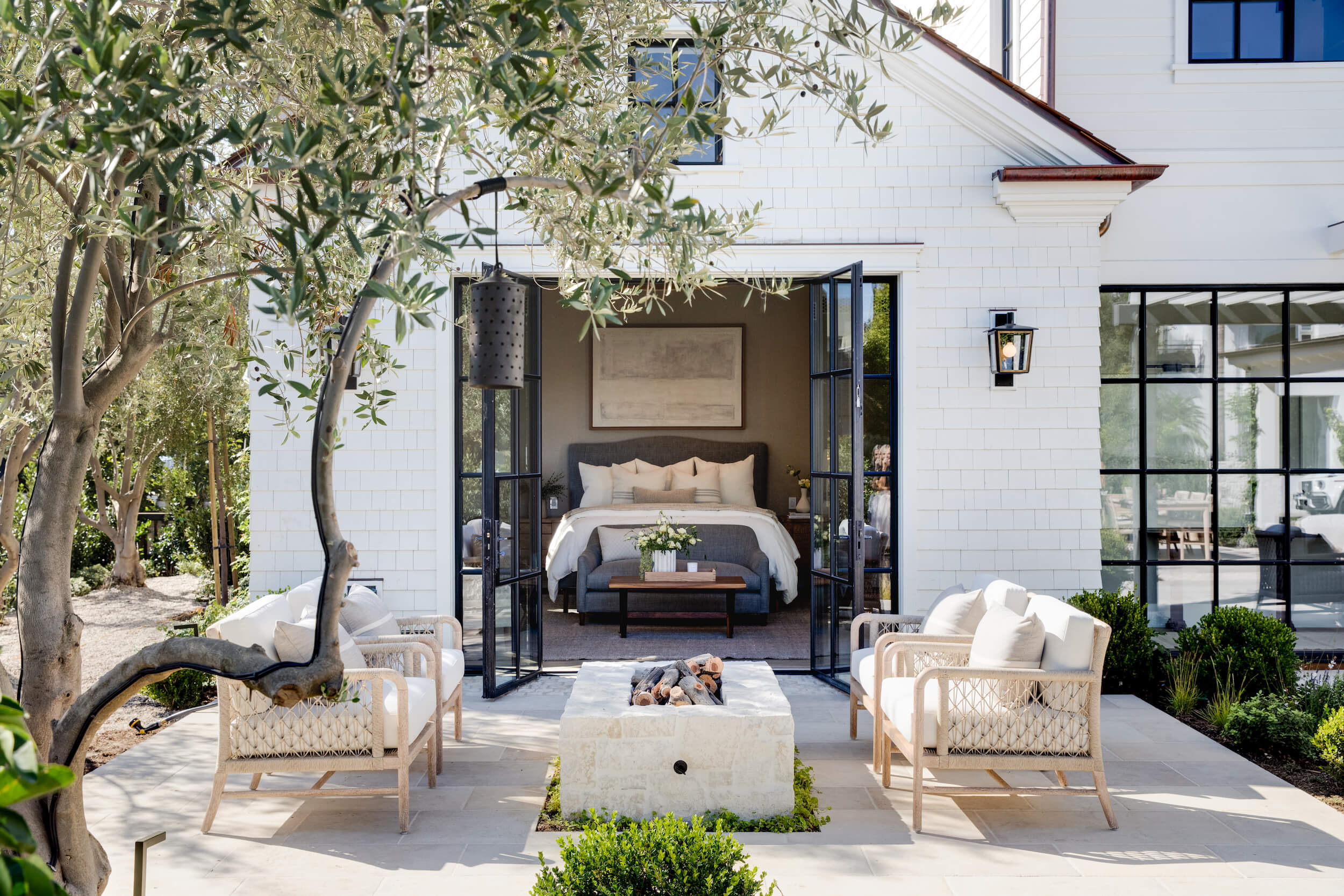
While you might have appreciated your firepit during the summer evenings, it comes even more into fall and winter, especially in states that drop in temperature a little, but don't go completely frosty. Not only does investing in good firepit ideas make an outdoor living room more inviting, they allow you to utilize the space for longer and enjoy extended al fresco gatherings in fall and winter.
"A firepit is more than just a stylish feature in a backyard; it's a transformative element that elevates the entire outdoor living experience," the experts at Garden Studio Design Team tell us. "A firepit does just that by establishing a dedicated destination within your landscape where family and friends can gather, socialize, and unwind."
But what are the factors to consider when thinking about installing a firepit area? And how can you create the perfect balance of form and function? Our experts are on-hand below to give you all the backyard ideas you need for a modern aesthetic and upscale outdoor living experience. Anyone for some s'mores?
1. Match Your Firepit with Your Home's Exterior for a Seamless Look
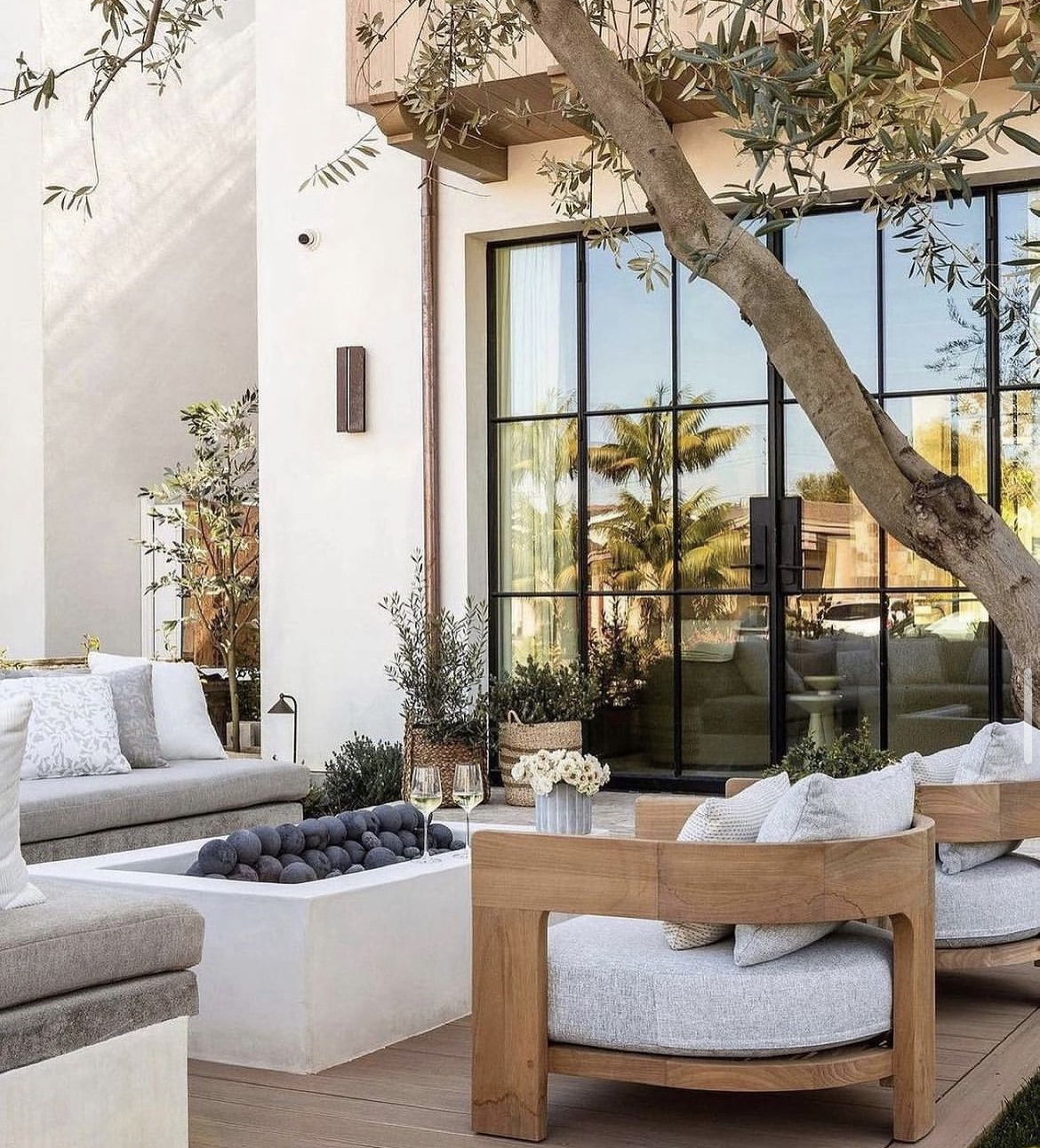
One way to ensure your firepit offers a curated and elevated aesthetic is to craft it with similar materials to your home's exterior. Keeping the two in sync works to create an elegant space that feels like a true extension of your home.
"When it comes to materials, the best choices depend largely on the surrounding architecture," the Garden Studio Design Team says. "We pay close attention to the home’s façade, whether it's traditional with brick or stone elements or more contemporary.'
"By incorporating similar materials into the face of a built-in firepit, we create a cohesive visual that harmonizes with the existing structure," he continues. "This thoughtful integration is key to balancing form and function, ensuring the firepit landscaping feels like a natural extension of the home rather than an isolated feature."
2. Choose Slurried Stones or Limestone for an On-Trend Aesthetic
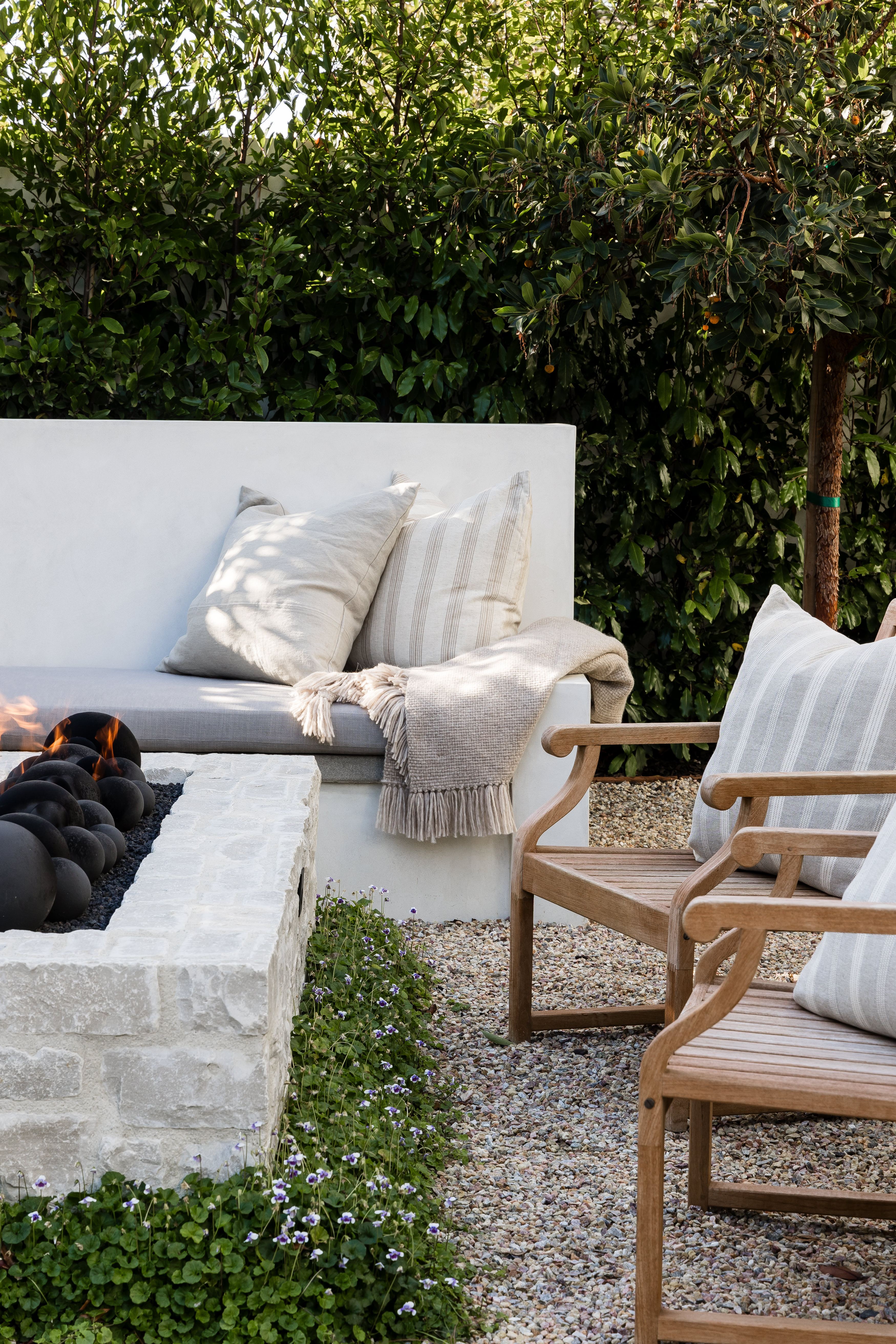
If you're looking for a modern but characterful firepit, choose limestone or slurried stone. It's an on-trend look that offers an organic-luxe appeal for backyard makeovers. "We’re seeing a rise in the use of slurried stones and limestone troughs for firepits," says the Garden Studio Design Team. "These materials are resonating with clients who crave a deeper connection to their surroundings."
The organic textures of slurried stones and the natural elegance of limestone not only grounds the design, but also brings a tactile quality that enhances the sensory experience of the outdoor space, the team tell us. "These choices reflect a broader desire to create environments that feel both luxurious and intimately connected to nature."
3. Opt for a Rectangular Firepit in a Larger Space
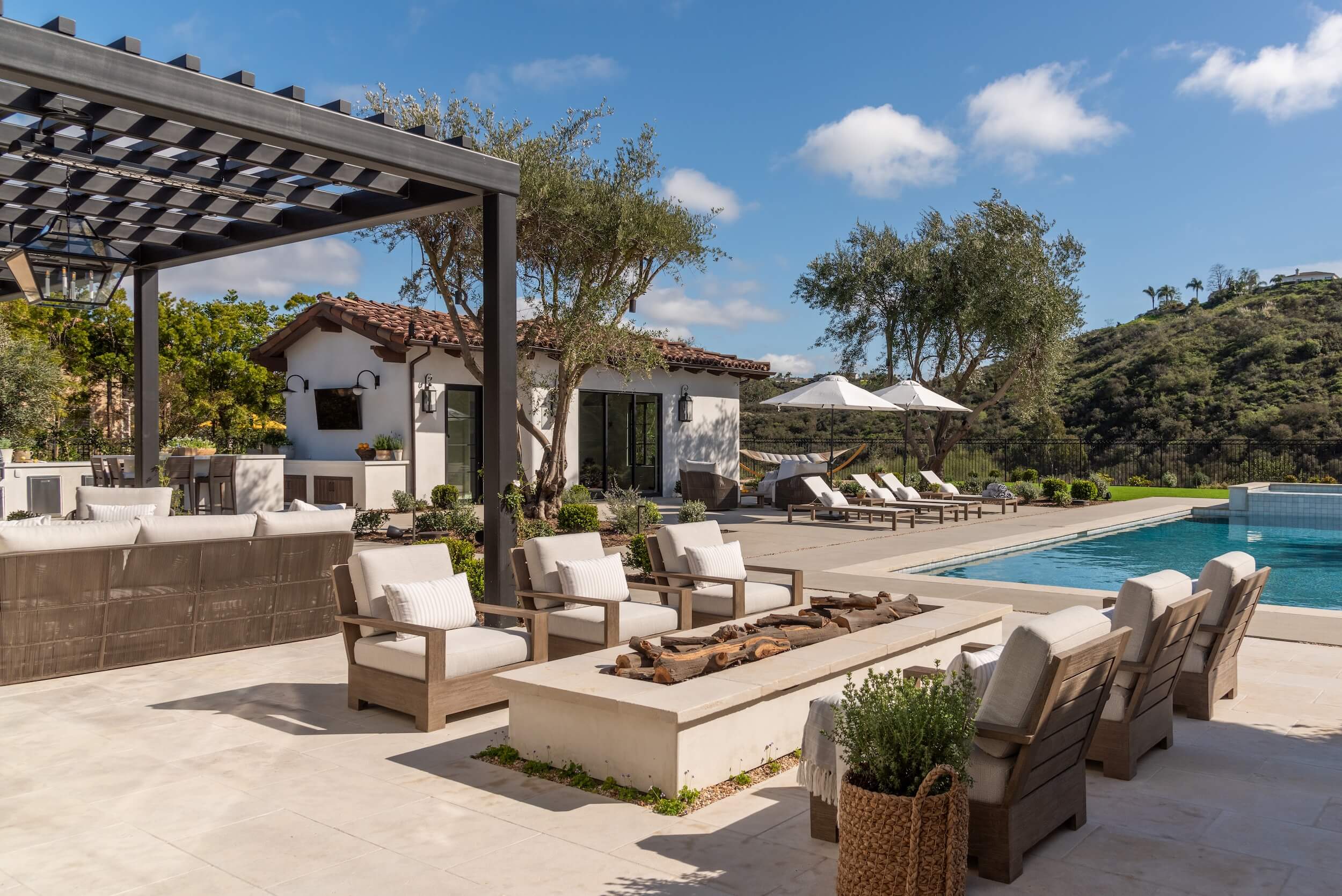
There's no hard and fast rule when it comes to the shape of your firepit. Sometimes it will be dictated by the space and the landscape, and other times simply by personal preference.
"Whether you’re looking to create a gathering place for larger groups or a private nook for quiet reflection, the shape of the firepit should enhance that experience, making it both functional and inviting," comments the Garden Studio Design Team. "The decision largely hinges on our client's preferences as well as how we see the firepit coming into play with the overall flow of the landscape design."
The team continues: "For larger spaces or when we’re incorporating built-in firepit seating, a rectangular firepit is often our go-to choice. This shape allows for a more communal experience, where everyone can sit comfortably and still feel connected to the warmth of the fire."
And how far away should the seating be? Garden Studio Design tells us there should be at least a 22-inch distance between the seat and the firepit, which strikes the perfect balance — you’re close enough to enjoy the heat of the fire without feeling the need to lean forward, while still leaving enough room for easy movement around the space.
4. Or Go Circular for an Intimate Vibe
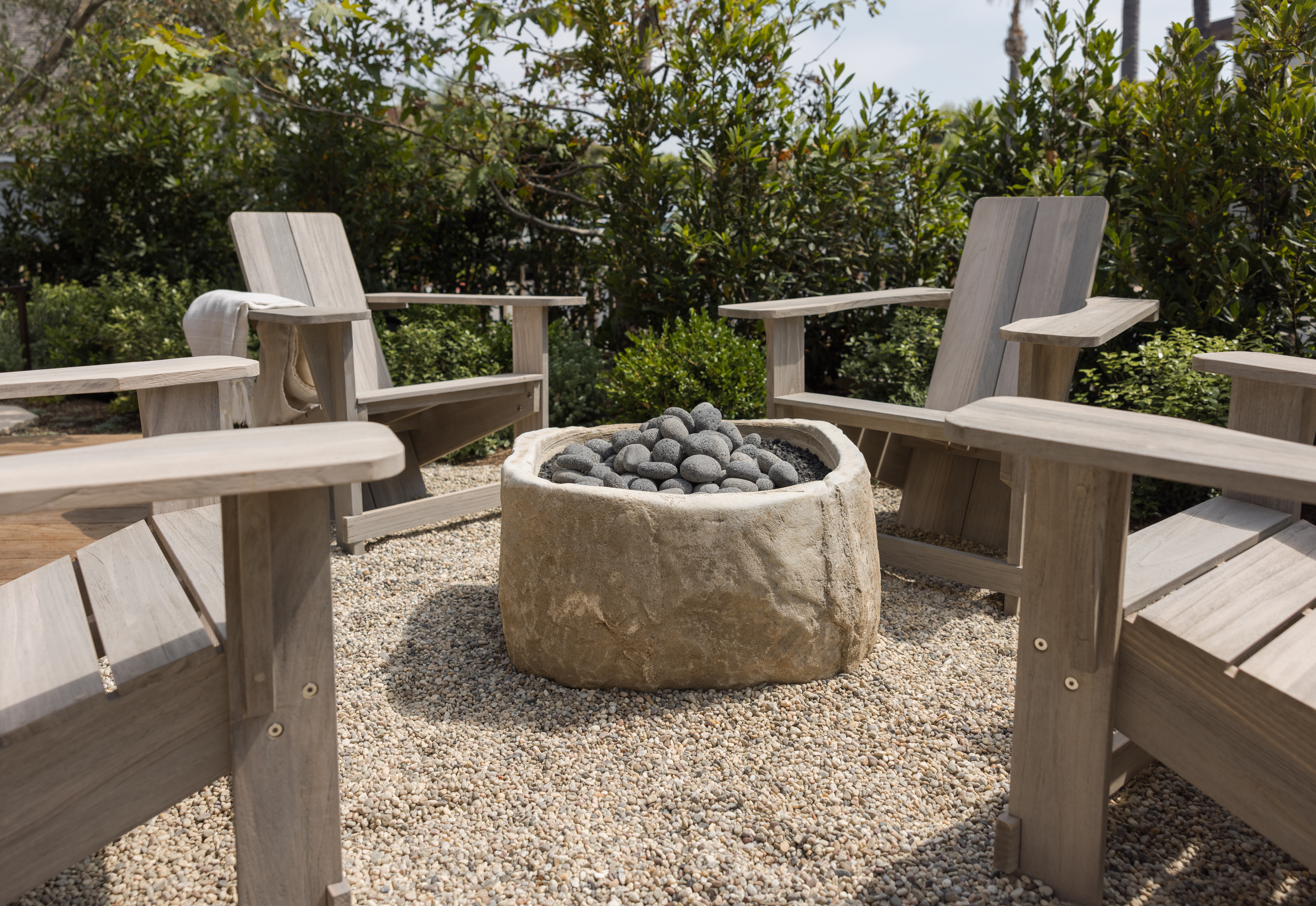
A round firepit is ideal for fostering conversation and a convivial atmosphere in a small backyard, as well as making the most of a stunning view.
"A circular or square firepit is ideal for more intimate, stand-alone spots, especially when the goal is to capitalize on a stunning vista," says Garden Studio Design. "This shape naturally encourages a more relaxed, campfire-like setting, where club chairs with deep seating can be arranged in a way that feels both cozy and open.
This style of design is perfect for spaces designed to focus on a central view, without anyone feeling they're too far from the action.
5. Contrast Pavers with a Warm Tone
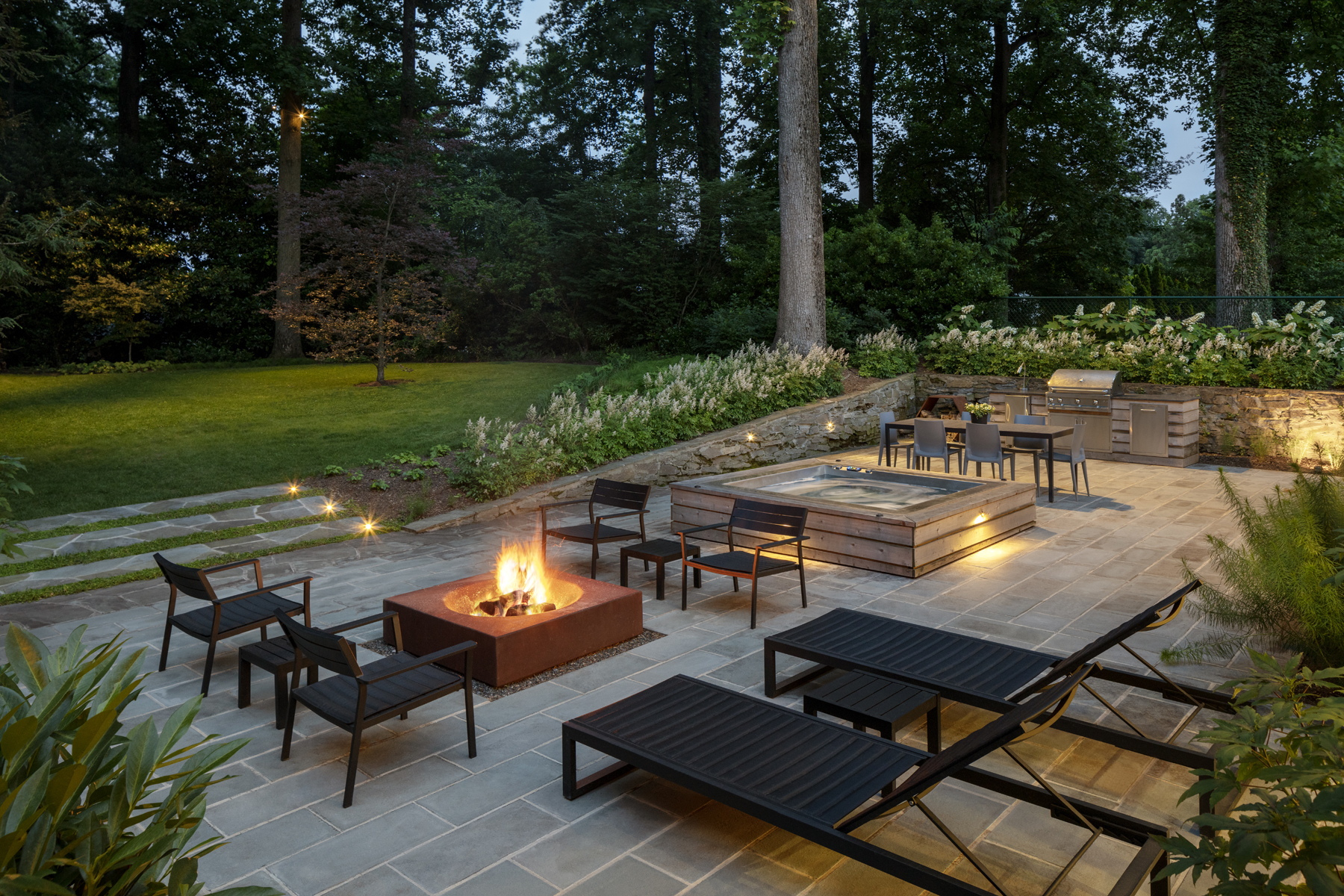
Adding a softly-hued firepit to an outdoor living room can work to create depth, dimension and visual interest in the space.
The square firepit in the space designed by Richardson & Associates Landscape Architecture above was crafted with corten steel. "The property design was mid century modern with a touch of zen so the corten steel material helped to tie that aesthetic together as well as introduce a warm tone to contrast all the stone used for the paving and walls," an associate at the firm, Marci Bonner, says.
A top tip for using corten steel? Marci adds: "As the rust from the corten may drip onto the pavement below, the bluestone does not go under the firepit. There is a pea gravel border around the perimeter of the firepit to catch any rust stains."
6. Install Built-In Seating For a Curated Look

"When it comes to choosing between built-in seating and stylish, separate furniture for your firepit area, the decision largely depends on personal preference and the specific considerations that are needed within a chosen space,' says the Garden Studio Design Team. "Built-in seating is a popular choice particularly for those seeking a more permanent, cohesive structure integrated into their landscape design," the team explains.
If built-in outdoor seating is the route you choose, the team also recommends incorporating custom upholstery into its design. This approach not only enhances comfort but also allows for the option of storing the cushions away during harsh winter months or inclement weather, extending their lifespan and maintaining their appearance.
7. Embrace Separate Seating for Flexibility

"For clients working within a limited footprint, moveable firepit seating is a great option," says Garden Studio Design.
"It offers flexibility, allowing you to rearrange or add more seating as needed, especially if you’re entertaining more guests than usual and require additional room to move about."
8. Consider Installing a Gas Line for Ultimate Convenience
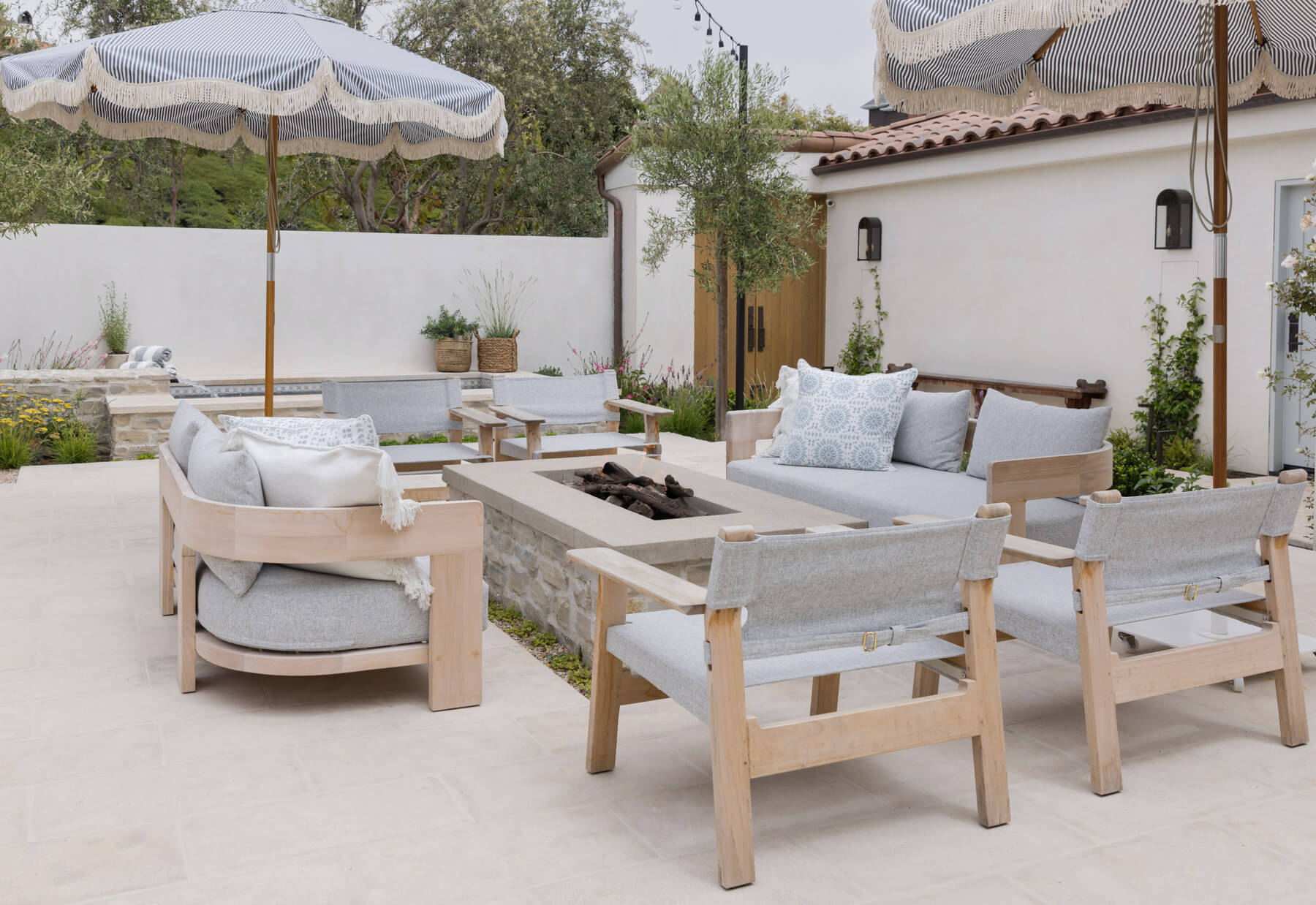
Getting down to the practicalities of firepits can feel confusing, but it's all about preference and what works best in the space and budget parameters. Depending on whether it's a gas vs wood firepit, you might want to think about the smoke heading back into your home as well as running gas pipes.
When it comes to fuel sources, the Garden Studio Design Team are a firm fan of gas. They explain: "When it comes to choosing a fuel source for your firepit, we typically recommend running a direct gas line. The primary reason is convenience; unlike wood or propane, a gas line doesn’t require frequent fuel replacement, which can be a hassle, especially when entertaining.
"Imagine hosting a gathering and suddenly running out of firewood or propane; there’s nothing worse than having to leave your own party to pick up more supplies, while your guests are left to retreat indoors if it’s chilly. A direct gas line ensures that the firepit is always ready to use with just the turn of a key, making it a seamless part of your outdoor living experience."
The team adds: "It’s important to note that installing a direct gas line requires the expertise of a professional, and you may need permission from your city or HOA in order to do so. While this adds a layer of careful planning and construction, the long-term benefits far outweigh the effort."
Ryan Saghian, Principal of Ryan Saghian Design, is also a fan of the gas fuel source. He says: "A gas firepit offers the warmth and ambiance of a traditional fire while being easier to control, cleaner, and more efficient. It’s also safer for an outdoor setting where maintaining the right atmosphere is crucial."
9. Or Go Back to Basics for a Rustic Ambiance
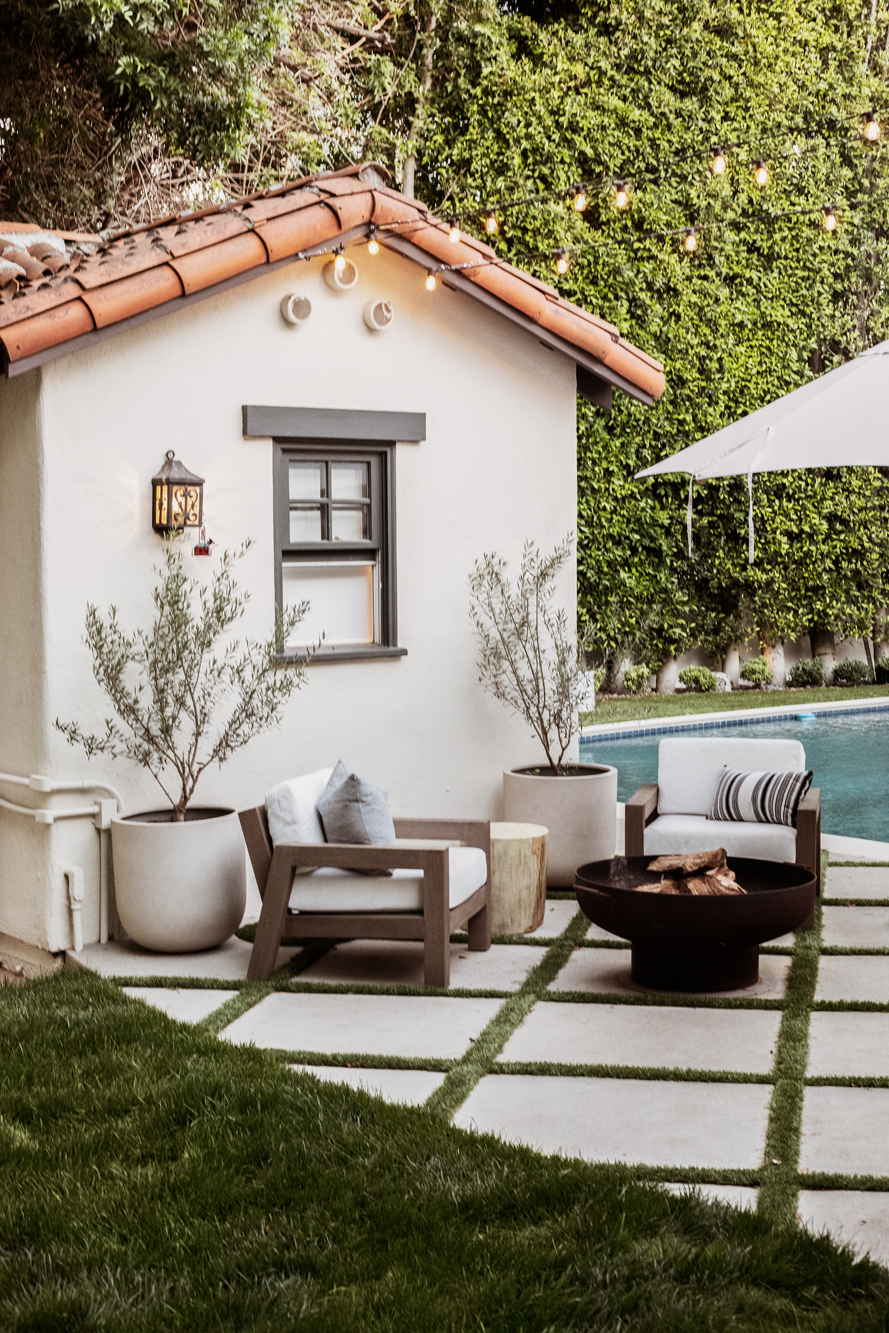
"Other fuel sources that we have considered in our projects vary based on the client's preferences and the specific ambiance they want to create," says Garden Studio Design. "For instance, wood-burning firepits offer a more traditional, rustic feel and the charming crackle of wood, which some people find irresistible. However, they do require more maintenance and fuel management."
The other type of firepit you could use is propane. "Portable Propane units are another option, offering low install costs and general ease of use," the team says. "Keep in mind that the use of these units come with the same drawback of potentially running out of fuel at an inconvenient time!"
He adds: "Ultimately, the best choice depends on how you plan to use your firepit and the level of convenience you desire. We strive to match the fuel source with the lifestyle and needs of our clients, ensuring their outdoor space is as functional and cozy as it is beautiful."
10. Pick Fire Media to Elevate the Look
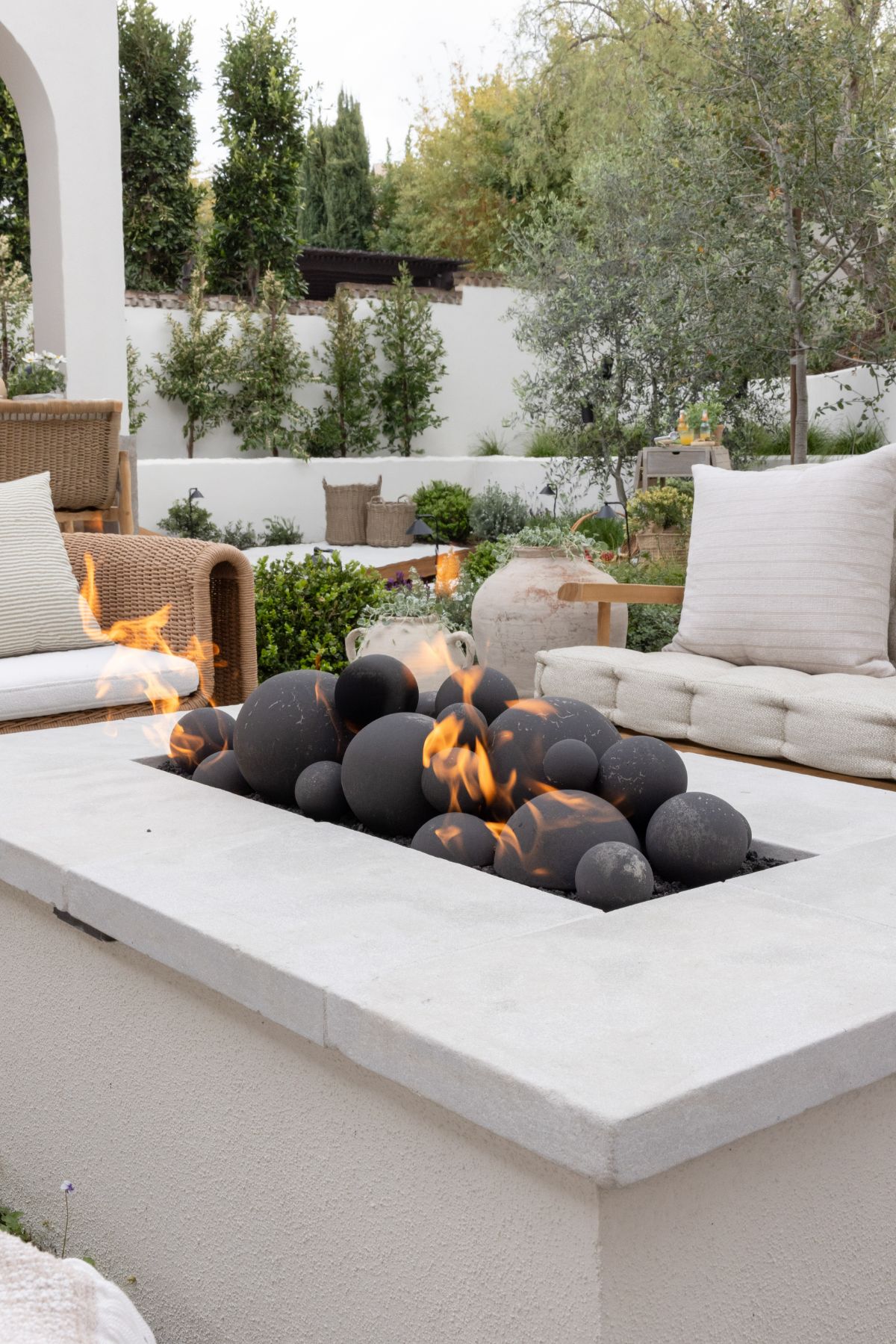
Fire media? What is that, we hear you say. Garden Studio Design explains: "Fire media, otherwise known as non-flammable decorative elements used in gas or propane firepits, offers a fantastic way to customize and enhance the design of your fire feature. We like to present our clients with a range of options to match their style and preferences.
"One of our favorite choices is stacked fireballs. These add a sleek, modern touch to the firepit, creating a visually striking effect as the flames dance around the geometric shapes."
Other options include stacked logs and lava rock.
"For a more natural and traditional look, lava rock is an excellent option," says the team. "Its rich, textured appearance adds depth and a touch of rugged elegance to the firepit, making it a versatile choice that complements various design styles.
"Another classic option we often recommend is faux stacked logs. These provide the appearance of a traditional wood fire while being entirely suited for use with gas or propane. They offer a warm, rustic feel that can evoke the charm of a campfire without the maintenance associated with real wood."
Each type of fire media can dramatically influence the ambiance and overall look of your outdoor space, allowing for a high degree of customization.
11. Warm Up Al Fresco Movie Nights
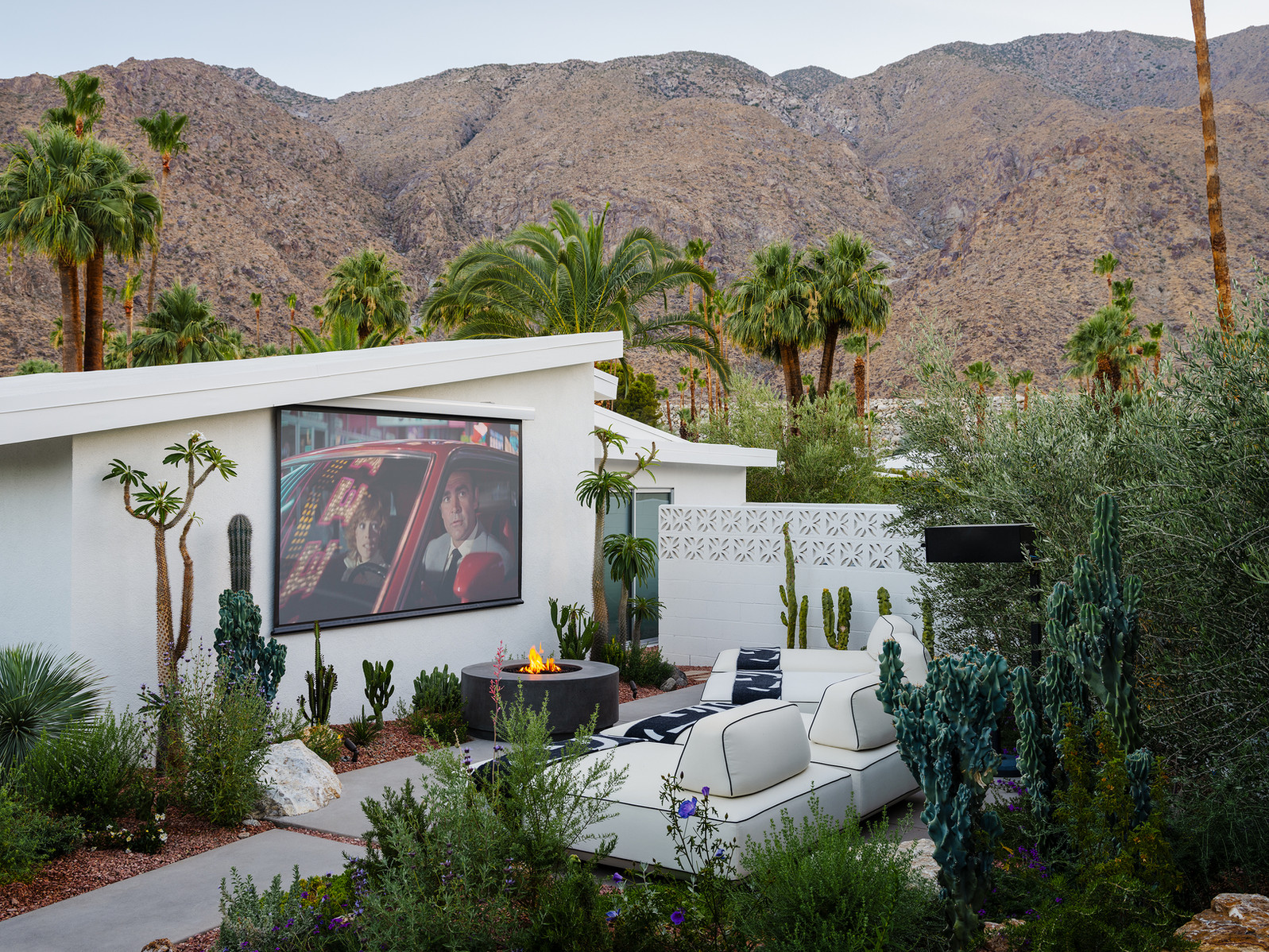
There's nothing more fun than backyard movie nights, but keeping snuggly under the stars is a big part of the experience. An firepit will add that extra ambiance for a truly magical showing for friends and family.
The sleek look by Ryan Saghian (above) is a masterclass in modern firepit ideas. "I went with high-quality materials designed to withstand outdoor elements while maintaining a sleek and sophisticated appearance," he says. "I selected a combination of concrete and metal for their durability and aesthetic appeal. The concrete provides a sturdy, robust foundation, while the metal details add a modern edge, aligning with the overall design language of the space."
"It’s a perfect complement to the cinematic setting, adding a touch of natural elegance that contrasts beautifully with the modern elements of the space."
FAQs
What Shape Firepit Should I Choose?
Lauren Lerner, Principal, Living with Lolo, says it's also a good idea to consider the house's architecture when choosing your firepit shape.
She comments: "Deciding between a rectangular and circular pit really depends on the rest of the space. You must consider whether you want to incorporate straight or curved lines to adhere to its surroundings."
Ryan Saghian agrees it's about the space and the feel you want to create. He comments: "While I do love the elegant simplicity of a circular firepit, the choice of shape ultimately depends on the space and the desired effect.
"A circular firepit often encourages a more communal, inclusive feel, ideal for gatherings where conversation and connection are key.
"However, in other settings, I might opt for a rectangular or linear firepit to better align with the architecture or to emphasize a particular design narrative. It’s always about finding the right balance between form and function, ensuring the firepit complements the overall aesthetic of the space."
What is the Cheapest Way to Make a Firepit Area?

"The cheapest way to make a firepit area would be to buy a freestanding one that's made of metal," says Linda Hayslett, Principal, LH. Designs.
You can then go about styling the area around it to make it inviting. Include things like potted plants, comfy seating, festoon lighting, and cozy cushions and throws for an inviting finish. Also think about investing a little into the ground surrounding the firepit.
Lauren says: "Crafting an outdoor firepit area involves carefully selecting materials, thoughtfully arranging furniture, and using landscaping to elevate the overall charm.
"Choose a freestanding metal firepit for an affordable option. Then, surrounding ground elements should be both heat-resistant and sturdy, with choices like concrete, stone pavers, pea gravel, crushed stone, or flagstone offering functionality and visual appeal."
Where is the Best Place to Put a Firepit in Your Yard?
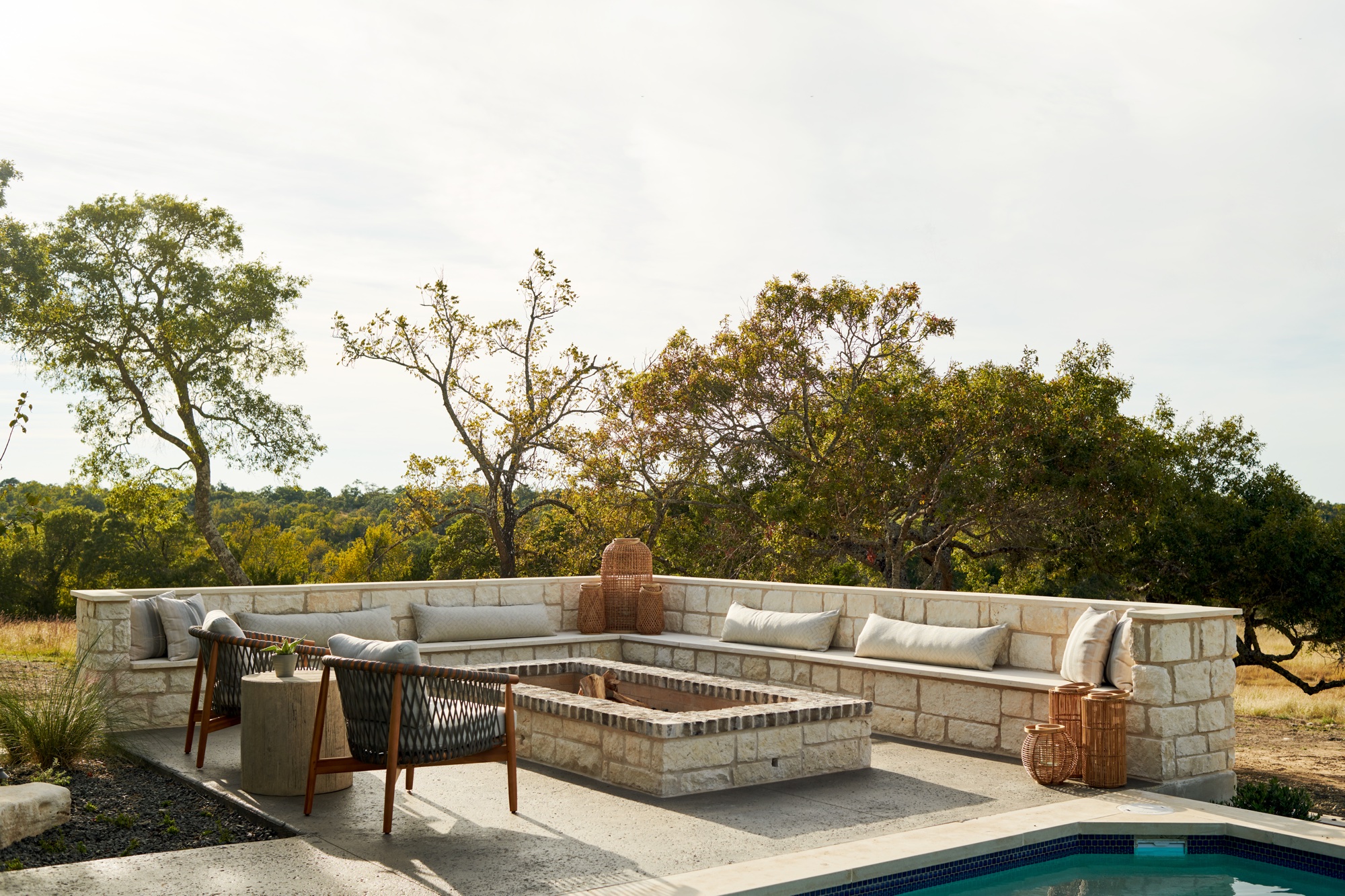
"The best place to put a firepit in the yard is in an open area and away from the structure of the home - at least 10' to 25' plus," says Linda Hayslett.
"This helps with any smoke and/or fire ambers that could catch on to the exterior of the home. But also, be conscious of any plants or vegetation as well.
"Open air places where there's not much around the pit are the most ideal spots in a yard."
The Garden Studio Design Team agrees that safety is paramount, commenting: "When determining the best location for a firepit in your yard, prioritizing fire safety and adhering to local and state regulations is essential.
"It’s important to assess potential risks to the environment and your family’s unique needs before beginning construction.
"Addressing the safety of children and pets is also a key element to consider when designing a firepit," he continues. "Placing these elements in locations that minimize the risk of accidental contact and incorporating features (like fire-proof protective barriers or glass screens) to keep young ones at a safe distance allows everyone to enjoy the firepit’s warmth and ambiance without compromising safety."
The team adds: "We also evaluate factors such as proximity to flammable materials (i.e. plants & trees), wind direction, clearance from structures, and the overall yard layout to ensure optimal placement.
"Given that regulations can vary, it’s crucial to research local guidelines to determine whether a firepit is a viable option for your space."







